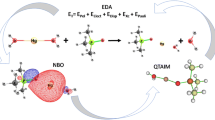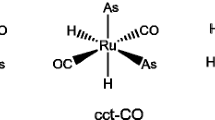Abstract
Based on second-order perturbation theory (MP2) predictions with large 6-311++G(3df, 3pd) basis set we have reviewed the possible structures and stabilities of a series of neutral MHn(M=Al, Ga; n=4, 5, 6) species. For AlH4 and AlH5, our results confirm the previous theoretical findings, which indicate the dihydrogen Cs complexes (2A′) AlH2(H2) and (1A′) AlH3(H2), respectively, as the lowest energy isomers. We found, similarly, Cs (2A′) GaH2(H2) and (1A′) GaH3(H2) van der Waals complexes as the most stable species of the gallium analogues GaH4 and GaH5. The calculated H2 dissociation energies (De) for AlH2(H2) and AlH3(H2) are of the order 1.8–2.5 kcalmol1, whereas this range of values for GaH2(H2) and GaH3(H2) is 1.4–1.8 kcalmol1 . Symmetry-adapted perturbation theory (SAPT) was used to analyze the interaction energies of these dihydrogen complexes (for n=5) to determine why the Ga species show a smaller binding energy than the Al species. The SAPT partitioning of the interaction energy showed significant differences between AlH3(H2) and GaH3(H2), resulting from the much stronger “hydride” character of the aluminum species. The experimental observation of AlH2(H2) and AlH3(H2), and likely GaH3(H2), via low-temperature matrix isolation has been reported recently by Pullumbi et al. and Andrews et al., supporting the theoretical predictions. For n=6, we found the degenerate C2(2A) and Cs(2A′) MH2(H2)2 “double H2” type van der Waals complexes as the lowest energy species for both M=Al and Ga.


Similar content being viewed by others
References
Grochala W, Edwards PP (2004) Chem Rev 104:1283–1315
Graetz J, Reilly JJ, Johnson J, Yu IA, Tyson TA (2004) Appl Phys Lett 85:500–502
Schüth F, Bogdanovic B, Felderhoff M (2004) Chem Commun 2249–2258
Zhu YF, Shehadeh R, Grant ER (1992) J Chem Phys 97:883–893
Köppe R, Kasai PH (1996) J Am Chem Soc 118:135–139
Parnis JM, Ozin GA (1989) J Phys Chem 93:1215–1220
Pullumbi P, Mijoule C, Manceron L, Bouteiller Y (1994) Chem Phys 185:13–24
Chaban G, Gordon MS (1997) Chem Phys Lett 278:195–201
Williams J, Alexander MH (2000) J Chem Phys 112:5722–5730
Pullumbi P, Bouteiller Y, Manceron L, Mijoule C (1994) Chem Phys 185:25–37
Wang X, Andrews L, Tam S, DeRose ME, Fajardo ME (2003) J Am Chem Soc 125:9218–9228
Wang X, Andrews L (2003) J Phys Chem A 107:11371–11379
Urban RD, Birk H, Polomsky P, Jones H (1991) J Chem Phys 94:2523–2528
Knight Jr LB, Banisakuas III JJ, Babb R, Davidson ER (1996) J Chem Phys 105:6607–6615
Pullumbi P, Bouteiller Y, Manceron L (1994) J Chem Phys 101:3610–3617
Wong SS, Li W-K, Paddon-Row MN (1991) J Mol Struct (Theochem) 226:285–301
Wiberg E, Amberger E (1971) Hydrides of the Elements of Main Groups I–IV. Elsevier, Amsterdam
Cheung YS, Ma NL, Li WL (1993) J Mol Struct (Theochem) 283:169–175
Schreiner PR, Schaefer III HF, Schleyer P (1995) J Chem Phys 103:5565–5569
Mitzel NW (2003) Angew Chem Int Ed 42:3856–3858
Becke AD (1993) J Chem Phys 98:5648–5652
Lee C, Yang W, Parr RG (1988) Phys Rev B 37:785–789
Wadt WR, Hay PJ (1985) J Chem Phys 82:284–298
Huzinaga S, Andzelm J, Klobukowski M, Radzio-Andzelm E, Sakai Y, Tatewaki H (1984) Gaussian basis sets for molecular calculations. Elsevier, New York
Pople JA, Binkley JS, Seeger R (1976) Intern J Quant Chem Symp 10:1–19
Frisch MJ, Pople JA, Binkley JS (1984) J Chem Phys 80:3265–3269
Perdew JP, Burke K, Ernzerhof M (1996) Phys Rev Lett 77:3865–3868
Perdew JP, Burke K, Ernzerhof M (1997) Phys Rev Lett 78:1396–1396
Zimmerli U, Parrinello M, Koumoutsakos P (2004) J Chem Phys 120:2693–2700
Frisch MJ, Trucks GW, Schlegel HB, Scuseria GE, Robb MA, Cheeseman JR, Montgomery JA, Vreven T, Kudin KN, Burant JC, Millam JM, Iyengar SS, Tomasi J, Barone V, Mennucci B, Cossi M, Scalmani G, Rega N, Petersson GA, Nakatsuji H, Hada M, Ehara M, Toyota K, Fukuda R, Hasegawa J, Ishida M, Nakajima T, Honda Y, Kitao O, Nakai H, Klene M, Li X, Knox JE, Hratchian HP, Cross JB, Adamo C, Jaramillo J, Gomperts R, Stratmann RE, Yazyev O, Austin AJ, Cammi R, Pomelli C, Ochterski JW, Ayala PY, Morokuma K, Voth GA, Salvador P, Dannenberg JJ, Zakrzewski VG, Dapprich S, Daniels AD, Strain MC, Farkas O, Malick DK, Rabuck AD, Raghavachari K, Foresman JB, Ortiz JV, Cui Q, Baboul AG, Clifford S, Cioslowski J, Stefanov BB, Liu G, Liashenko A, Piskorz P, Komaromi I, Martin RL, Fox DJ, Keith T, Al-Laham MA, Peng CY, Nanayakkara A, Challacombe M, Gill PMW, Johnson B, Chen W, Wong MW, Gonzalez C, Pople JA (2003) Gaussian 03, Revision B.01. Gaussian Inc, Pittsburgh
Schaftenaar G, Noordik JH (2000) J Comput Aided Mol Des 14:123–134
Bober K, Mierzwicki K, Moc J (2004) In: Proceedings of Winter School in Theoretical Chemistry 2004. A Frontier of Chemistry: New Species. Helsinki, Finland, December 13–16, p 25
Jeziorski B, Moszynski R, Szalewicz K (1994) Chem Rev 94:1887–1930
Williams HL, Szalewicz K, Jeziorski B, Moszynski R, Rybak S (1993) J Chem Phys 98:1279–1292
Bukowski R, Cencek W, Jankowski P, Jeziorski B, Jeziorska M, Kucharski SA, Misquitta AJ, Moszynski R, Patkowski K, Rybak S, Szalewicz K, Williams HL, Wormer PES (2002) In: SAPT2002: An ab initio program for many-body symmetry-adapted perturbation theory calculations of intermolecular interaction energies. Sequential and Parallel Versions. see: http://www.physics.udel.edu/∼szalewic/SAPT/SAPT.html
Author information
Authors and Affiliations
Corresponding author
Electronic supplementary material
Rights and permissions
About this article
Cite this article
Moc, J., Bober, K. & Panek, J. On the existence of MHn species with M=Al, Ga and n=4, 5, 6. Computational study of structures, stabilities and bonding. J Mol Model 12, 93–100 (2005). https://doi.org/10.1007/s00894-005-0010-1
Received:
Accepted:
Published:
Issue Date:
DOI: https://doi.org/10.1007/s00894-005-0010-1




